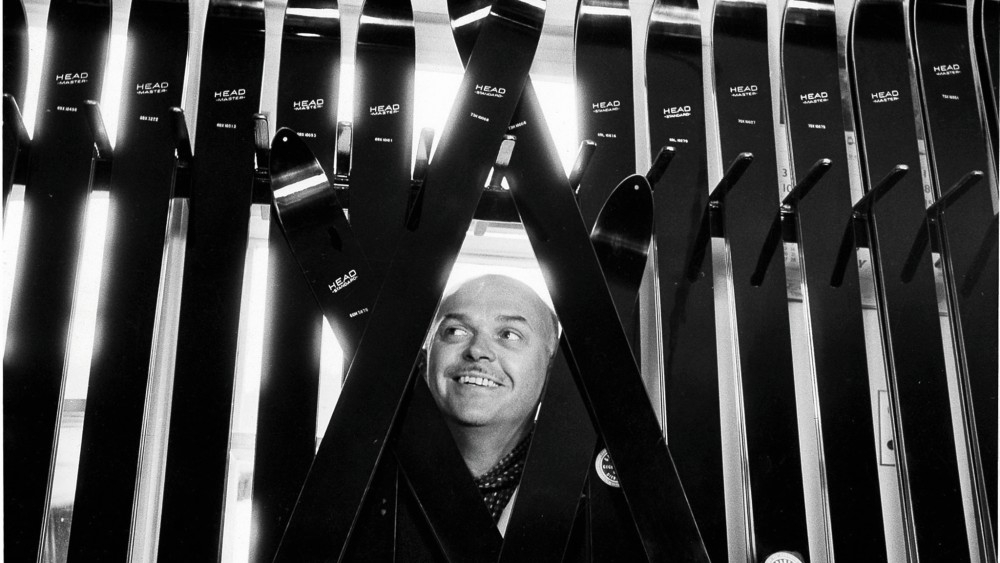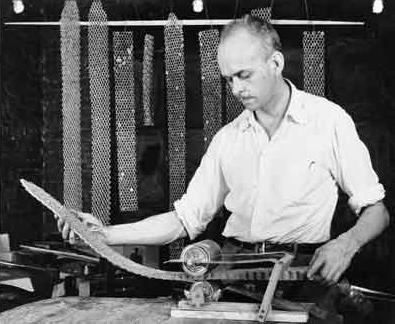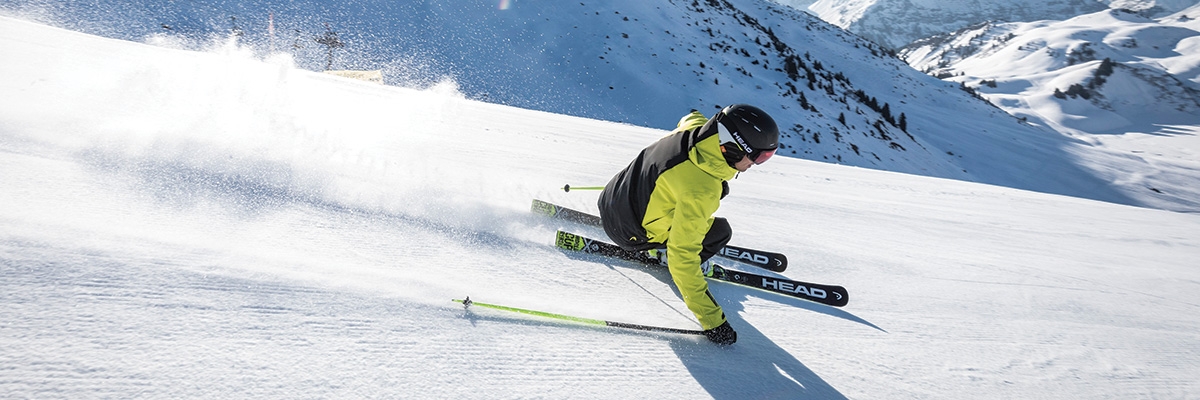Despite being an awkward, gangly athlete, Howard Head brought a designer’s mindset to sports, going on to transform two sports - skiing and tennis - through his inventions.
In March 2017, Howard Head, the founder of Head Ski, was inducted into the National Inventors Hall of Fame for his ski and tennis racket inventions. Howard’s journey however, into becoming an excellent skier was anything but smooth.
In the winter of 1947, Howard Head was taking a train from Stowe, Vermont back to his home in Baltimore, Maryland with some friends. He had just tried skiing for the first time and was shocked at how bad he was at the sport. Head was a tall man at 6 foot 4 inches. He struggled with skiing and later described his experience as humiliating and awful. He kept crashing and hurt himself numerous times. Every time, he tried to do a snowplow, he ended up face first in the snow. He could not believe how hard it was for him to learn the sport.
He realized though that some of his clumsy efforts at skiing were perhaps due to the skis themselves. The skis were made of wood and were long, heavy and clumsy. Head blamed the skis that he used for some of his skiing troubles and decided that he needed to build new skis out of a different material. His line of thinking was that a better design using lightweight aircraft materials would transform skis and make them easier to maneuver and a better skiing experience for anyone, from amateurs like himself to competitive skiing professionals.
"If wood were the best material, they'd still be making airplanes out of wood," Head said.
On the train ride back to Baltimore, Head began to sketch out his rough idea on a napkin. The 32-year-old engineer thought that he could design better skis built out of aircraft aluminum and plastic.
An aeronautical engineer by trade at the Glenn L. Martin Company, where he designed and built planes during World War II, Head had graduated from Harvard in 1936 with a degree in engineering sciences. Head persisted in his efforts and three years later, he launched his first product, a new metal ski with a revolutionary design under a new company, Head. Head Skis changed skiing forever. The new skis were lighter, easier to turn and more durable. The ease of use made skiing more accessible for new skiers. Head was so successful that the company’s skis dominated the growing ski manufacturing market, contributing almost half of all skis across the country for the next 20 years.
Here are four powerful lessons we can learn from Howard Head’s creativity and inventions.
Lesson #1: Pursue Goals You Care About On a Personal Level
Image via Head
“With both my skis and my racket I was inventing not to just make money, but to help me. I invent when it’s something I really want. The need has to grow in your gut. People who go around trying to invent something generally fall on their tails. The best inventions come from people who are deeply involved in trying to solve a problem.”
It is important to work on ideas that you are fully invested in; that are specific; and that you care so much about that you are willing to troubleshoot and figure out necessary details carefully.
Engineering draws upon science and mathematics to design new solutions, whether they are devices or systems. However, engineering progresses through the efforts of individuals who have a strong personal motivation to achieve a solution. This motivation can inspire an individual to acquire necessary analytical skills and engineering precision in order to fulfill a desired vision. Passion can lead to the most innovative results.
Lesson #2: Have Strong Self-Awareness
Born in 1914 in Philadelphia, Howard Head had a keen interest in literature and poetry. He went to Harvard University to study English and struggled for two years, but discovered that he was not a good writer. He worked as a copy boy and for newsreels but was unhappy with his performance and the jobs he took. Unsure of what to do next, Head went to a career counselor who encouraged him to take career tests to determine the right vocation. He took an aptitude test where he scored perfectly on the test for structural visualization or the process of imagining machines in three dimensions. He decided to pursue an engineering degree instead. After graduation, Head went on to work at the Glenn L. Martin Aircraft Company in Baltimore, Maryland where he built and designed B-26 attack bombers and PBM-3 flying boats. He started out as a riveter and then became an aeronautical engineer during World War II. At Martin, he also designed the B-26 Marauder, a twin-engine bomber. The exterior of the B-26 Marauder was an aluminum alloy sandwich wrapped around a honeycomb structure. It was the first WWII aircraft to use plastic on a large scale. Head would use this experience to build his skis.
Head knew what he was good at and what he did not do well, even if it was a subject he enjoyed. Self-awareness is key to achievement.
Lesson #3: Persistence
Image via Head
Image via Head
“If I had been a dedicated skier when I went to Stowe, I probably would’ve accepted as gospel the idea that skis had to be of wood. But as a novice, I thought wooden skis were crude.”
When Head did not enjoy his ski vacation because he could not easily maneuver the heavy wooden skis that he had, he decided to build his own, using different lighter materials. People were skeptical of his ideas and he faced numerous design setbacks but he kept going. He persisted and did not give up.
He took the $6,000 that he had won from playing poker and rented a small section of an electrical appliance shop from Albert Gunther Inc in an alley off of Biddle Street in Baltimore, Maryland. Head then scrounged aluminum scraps at Martin Aircraft. He quit his job and got to work building his first prototype for a flexible laminated ski. He convinced three mechanics from Martin Aircraft to work with him during the evenings and weekends. They built not only the skis, but the equipment to build the skis. Together, Head and his production team built six pairs of skis that first year. The skis were essentially metal sandwiches — two layers of aluminum with plywood sidewalls around a plastic honeycomb core.
Head used structural principles from the aircraft industry and new lighter materials to build better ski equipment. His efforts revolutionized the ski industry, taking it out of the hands of wood crafters and placing it squarely in the domain of scientists and engineers.
Head rushed back to Stowe, Vermont during Christmas time in 1948 to show his skis to ski instructors. Six of the seven pairs that Head brought to demo, broke just as the instructors flexed them with their hands. Head skied on the last pair and then it broke.
One of the Stowe instructors, Neil Robinson, encouraged Head and offered to keep testing his new ski creations. That positive reinforcement was enough to keep Head at it. Head did not give up. Head kept designing new skis and sending them to Robinson, who would test them and then send them back when they broke. Head was able to see all the flaws in his designs and to keep improving. By the end of the first winter, Head was able to create skis that were half as heavy but equally strong as the traditional wooden pairs in use. He built 39 more versions in the next two years. They all broke.
“Every time one of them broke, something inside me snapped with it.”
Despite the repeated failures, Head refused to give up. He ran out of money and turned to his friends for support, borrowing cash to continue his venture. His persistence convinced his production team to stay on even when he could not pay them. After three years of failure, Head was almost ready to give up. He was living in a basement apartment for $20 a month. He had not paid his crew for a year and a half, and he was washing his dishes in his bathtub. He realized that he had to make it work or quit and get another job. Head persisted and in the spring of 1950, he showed up at Tuckerman's Ravine in New Hampshire and asked 10th Mountain Division veteran, Clif Taylor, who had tested prior versions for Head, to try out some new skis.
Taylor did and to their mutual excitement, the new skis worked in every conceivable snow condition!
It took Head three years since that fateful trip to Stowe, Vermont, but in 1950, he figured it out. He designed and built the Head Standard, a flexible ski made of metal, plastic and plywood that was three times more flexible than wooden skis and could turn easily in any ski condition.
“If I had known then that it would take 40 versions before the ski was any good, I might have given it up. But, fortunately, you get trapped into thinking the next design will be it.”
Head traveled across the country selling his new skis out of his station wagon at ski resorts and parking lots. The skis sold quickly. At first, people were skeptical and labeled them ‘cheaters’ as they made turning so much easier. Head Skis were selling like hotcakes in Colorado and New England, with ski instructors encouraging new students to only ski with the new equipment!
Image via Head
Head’s new ski revolutionized the sport. By 1966, the Head Ski Company employed 500 people, was selling 300,000 skis a year in 17 countries and earning $25 million annually. Soon enough, Head Skis were in use by Olympic skiers both in the United States and Europe, dominating competition at the 1964 and 1968 Winter Olympics. At the 1964 Olympics in Innsbruck, Austria, Billy Kidd from Steamboat, Colorado became the first American man to win an alpine skiing medal. He won a silver medal in the slalom on Head skis.
Howard Head had succeeded in revolutionizing the ski industry, encouraging new people to try out the sport, making skiing easier overall and helping people become better skiers.
“In the long run, it’s the details that make ideas work.”
Image via Head
Lesson #4: Keep Going
Patent diagrams comparing the “sweet spots” in Head’s tennis racket [5A] and a traditional racket [5B]. The “sweet spot” in Head’s racket is labelled zones 33, 35, 37 which are significantly larger in area than the corresponding zones 33’, 35’, and 37’ in the traditional racket. Howard Head, “Tennis Racket,” US Patent 3,999,756 (filed 10 Sept. 1975, granted 28 Dec. 1976).
Pam Shriver playing with a Prince racket during a semi-final match against Martina Navratilova at the U.S Open Tennis Championship, September, 1978. The sixteen-year-old Shriver upset the number-one seeded Navratilova to become the youngest finalist ever in the U.S Open Tennis Championship. (AP Photo/Dave Pickoff)
Head could have sat on his laurels. He had achieved a lot and his business was thriving. However, he chose to keep going and using his inventive mind to create a new, oversized tennis racket. Just like his start in designing skis, Head became motivated to create a new tennis racket based on his own tennis playing experience.
In 1971, Head sold his business to AMF for $16 million, explaining that the company had grown beyond his ability to manage it. He took up tennis in retirement at the age of 60 and built a court underground at his home. He spent a lot of money and effort into learning how to play tennis. He did not improve though the way that he had hoped. Head purchased a Prince ball machine to practice playing tennis. He redesigned the machine and invested in the company, patenting the improvements that he had made. His tennis playing however did not improve!
Out of the blue, he had an idea to make the tennis racket bigger and so he did. The process took him two years and he constructed a tennis racket that was 20 percent wider than the old wooden rackets, one inch on each side. This in turn, gave the racket a 40 percent larger “sweet spot.” A sweet spot is the optimum place on a racket face for impact with the ball. Just like he had replaced wood in skis with a lighter material, Head substituted aluminum into the tennis racket’s wooden frame. Later, he used graphite. Prince sold the new tennis racket in 1976.
Similar to the resistance that Head encountered when he introduced his metal skis, he faced snickers and derision with his new larger tennis racket, that many called a “snowshoe” racket. The new Prince Classic, as the tennis racket was called, nonetheless, became an instant hit with tennis players.
Head successfully improved upon an existing product to enhance performance. As tennis player Pam Shriver demonstrated in 1978, the new racket design was a tremendous success. Within four years of the product’s launch, over 700,000 tennis players around the world were using it.
In two years, Prince Manufacturing controlled 30 percent of the U.S. market, 25 percent of the global market and dominated global racket sales. Howard Head, the tennis newbie, who could not play tennis well, had turned out to be one of the industry’s biggest innovators.
A consummate entrepreneur, Head received a royalty payment on every Prince racket sold. He sold the company to Chesebrough-Ponds for $62 million in 1982.
Howard Head kept on playing tennis and skiing down mountains for the rest of his life. Head got married to Martha Fritzler who shared his love of skiing and settled in Vail. Head went on to launch the Howard Head Sports Medicine Center to help athletes in 1987 and also supported numerous other causes. He was inducted into the Colorado Ski and Snowboard Museum Hall of Fame in 1990 at the age of 75, a year before he passed away. Head is remembered to this day with fondness at the ski slopes he frequented in Aspen and Vail, Colorado. His two inventions - the metal ski and oversized tennis racket - are on permanent display at the Smithsonian Institute with the inscription praising Head as the "patron saint of average athletes."
Howard Head's quotes in this story are taken from stories previously published by the Vail Daily, the Vail Trail, the Colorado Ski and Snowboard Museum Hall of Fame, Sports Illustrated (Sept. 29, 1980) and Airport Journal "A Bad Skier's Revenge," (Nov. 5, 2005).
View prior profiles by searching for Profiles. Read our Profile on U.S. Skiers and Snowboarders at the 2018 Pyeongchang Olympics. Learn more about our Elf Ski app that we’re developing that helps skiers and snowboarders track their workouts and improve performance.










![Patent diagrams comparing the “sweet spots” in Head’s tennis racket [5A] and a traditional racket [5B]. The “sweet spot” in Head’s racket is labelled zones 33, 35, 37 which are significantly larger in area than the corresponding zones 33’, 35’, and …](https://images.squarespace-cdn.com/content/v1/54bdcba5e4b08f92b173441f/1549822432194-NVWVA0MFE9C9ZHIBBAFE/HeadRacketPatent.png)
